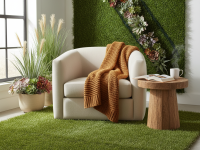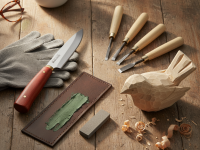Ever gazed at a plain piece of furniture and imagined intricate patterns blooming across its surface? Perhaps a delicate vine snaking up a chair leg, a classic rosette adorning a cabinet door, or a geometric motif transforming a humble chest? That’s the magic of relief carving, and when applied to furniture, it doesn’t just decorate; it tells a story, adds character, and elevates a simple object into a cherished heirloom.
If you’re anything like me, the thought of taking a sharp tool to wood can be both exhilarating and a little daunting. Where do you even begin? What tools do you need? This isn’t just about carving a small figurine; it’s about making a lasting impression on something as substantial as a table or a wardrobe. That’s why choosing the right wood carving tool kit for relief carving on furniture is paramount. It’s the difference between a frustrating struggle and a rewarding artistic journey.
In this guide, we’re going to dive deep into the world of carving tools, sharing insights gained from countless hours at the workbench. We’ll demystify what makes a good kit, what to look for, and how to set yourself up for success, whether you’re just starting out or looking to upgrade your arsenal. So, grab a cup of coffee, settle in, and let’s talk wood carving!
Why Relief Carving on Furniture? It’s More Than Just Decoration
You might be wondering, “Why bother carving furniture when there are so many other ways to decorate it?” And that’s a fair question! But relief carving offers something unique. It adds a tactile, three-dimensional quality that paint or veneer simply can’t replicate. Imagine ruing your hand over a smooth, cold wood surface, then encountering the warmth and texture of a hand-carved leaf. It engages more senses, creating a deeper coection with the piece.
For me, it’s about giving an object a soul. A mass-produced table might be functional, but a table with a carved apron feels personal, crafted, and carries a sense of history—even if you’re the one making that history. Relief carving can transform ordinary furniture into a focal point, reflecting your personality, heritage, or artistic vision. It also allows for restoration, bringing life back to antique pieces that have lost their original charm.
Decoding the Kit: What Tools Do You REALLY Need?
When you first look at a carving tool catalog, it can feel like stepping into an ancient armory. Gouges, chisels, V-tools, knives – where do you start? For relief carving, especially on furniture, a versatile set is key. Here’s a breakdown of the essential tool types you’ll find in a good kit:
Gouges: The Workhorses of Relief Carving
- Sweeps and Curves: Gouges are curved chisels, and they come in a vast array of “sweeps” (how deep the curve is) and “widths.” You’ll use them to scoop out wood, define contours, and create rounded forms. For furniture, you’ll need a good range, from shallow sweeps for subtle curves to deeper ones for more dramatic relief.
- Fishtail Gouges: These have a narrow shank that flares out to a wider cutting edge, making them excellent for reaching into tight corners or undercutting details.
Chisels: For Flatness and Finesse
- Straight Chisels: Essential for cleaning up flat backgrounds, squaring off edges, and creating crisp lines. You’ll want a few different widths.
- Skew Chisels: The cutting edge is at an angle, making them superb for cleaning out corners and precise detail work where a straight chisel might struggle.
V-Tools: The Outline Masters
- Defining Shapes: A V-tool, as the name suggests, has a V-shaped profile. It’s invaluable for outlining designs, creating crisp lines, and defining areas before you start removing larger amounts of wood with gouges. They typically come in different angles, such as 60 or 90 degrees.
Knives: For Detail and Finishing Touches
- Detail Knives: While not always the primary tool for large furniture carving, a good detail knife is indispensable for refining small areas, undercutting delicate details, and cleaning up tight spots that larger tools can’t reach.
The Often Overlooked Mallet
For furniture carving, especially when removing larger amounts of wood or working with tougher species, a carving mallet is your best friend. It provides the necessary force to drive your gouges and chisels efficiently, saving your hands and speeding up the process. A wooden or rawhide mallet is generally preferred over a metal hammer to avoid damaging tool handles.
What Makes a Kit ‘Good’? Your Buying Checklist
Now that you know the types of tools, how do you sift through the countless kits available? Here’s my personal checklist for evaluating a wood carving tool kit:
1. Steel Quality: The Heart of the Tool
This is arguably the most crucial factor. High-quality steel (often high-carbon steel) will hold an edge longer, meaning less time sharpening and more time carving. It also takes a finer edge, allowing for smoother cuts and more precise work. Cheap steel dulls quickly and can be frustratingly difficult to sharpen properly. Look for tools that specify the type of steel used, and ideally, where it’s forged.
2. Handle Ergonomics: Your Hand’s Best Friend
You’ll be holding these tools for hours. An uncomfortable handle leads to fatigue, cramps, and can even compromise safety. Look for handles made of hardwood (like beech, ash, or hornbeam) that fit comfortably in your hand. Octagonal handles are popular for good grip and preventing rolling, but round or pear-shaped handles can also be great if they fit your specific hand shape.
3. Variety vs. Specialization: What’s in the Box?
- Begier Kits: Often come with 6-12 basic tools, usually a mix of flat chisels, a couple of gouges (shallow and medium sweep), and perhaps a V-tool. These are excellent for learning the fundamentals without overwhelming you.
- Intermediate/General Purpose Kits: Will offer a wider array of sweeps and widths, allowing for more complex designs. These might have 12-24 pieces, offering a good balance of versatility.
- Specialized Kits: Less common as “kits,” these are often built up tool-by-tool by experienced carvers. If you’re tackling specific styles (e.g., chip carving, specific relief styles), you might find kits tailored to those needs, featuring unique blade profiles. For furniture, a good general-purpose kit is usually the best starting point, allowing you to add specialized tools as your skills evolve.
4. Sharpness Out of the Box: A Good Indicator
While almost all carving tools will benefit from a personal sharpening and stropping session before use (more on that later!), a kit that arrives with a reasonably sharp edge is a good sign of quality control. It shows the manufacturer cares about the readiness of their product.
5. Brand Reputation: Trust in Experience
Some brands have been making carving tools for generations and have earned their reputation for a reason. While I won’t name specific brands here to keep this advice evergreen, doing a quick search for “best wood carving tool brands” will give you a list of trusted manufacturers. Investing in a reputable brand often means better steel, craftsmanship, and customer support.
6. Price Point: An Investment, Not Just a Purchase
Good carving tools are an investment. While there are budget-friendly options, be wary of kits that seem “too good to be true” price-wise. They often feature poor-quality steel that won’t hold an edge, leading to frustration. It’s often better to buy a smaller, high-quality kit and expand later than to buy a large, cheap kit you’ll soon want to replace.
My Personal Carving Journey: Tips from the Bench
Having spent many hours covered in wood shavings, I’ve learned a few things that aren’t always in the instruction manual. Here’s some wisdom I wish I’d known from the start:
1. Sharpening is KING: No Excuses!
I caot stress this enough: a sharp tool is a safe tool, and a sharp tool makes carving enjoyable. A dull tool requires more force, is harder to control, and leads to tearing wood, frustration, and a higher risk of injury. Learn to sharpen your tools correctly from day one. Invest in good sharpening stones (coarse, medium, fine) and a leather strop with honing compound. It feels like a chore at first, but it quickly becomes a meditative ritual and vastly improves your carving experience.
2. Start Simple, Practice Often
Don’t jump straight into carving an elaborate design on your grandmother’s antique dresser. Start with scrap wood – basswood, pine, or even poplar are great for practice. Begin with simple geometric patterns or basic leaf designs to get a feel for your tools and how different cuts affect the wood. Understanding grain direction is crucial; practice cutting with, across, and against the grain to see the results.
3. Patience and Persistence are Your Allies
Relief carving, especially on furniture, takes time. There will be frustrating moments, cuts that don’t go as plaed, or times when you feel like you’re not making progress. Take breaks, step back, and remember it’s a marathon, not a sprint. Every mistake is a learning opportunity.
4. Safety First, Always!
Those tools are sharp – as they should be! Always wear cut-resistant gloves on your non-dominant hand (the one holding the wood or guiding the blade). Secure your workpiece firmly with clamps or a carving vise. Always carve away from your body. Eye protection is also a good idea, especially if you’re using a mallet.
Beyond the Box: Essential Carving Companions
While a good tool kit is your foundation, there are a few other items that will greatly enhance your carving journey:
- Sharpening System: As mentioned, this is non-negotiable. Diamond plates, water stones, oil stones, and a strop are all part of a comprehensive sharpening setup.
- Clamps or Carving Vise: You absolutely need to secure your workpiece. A loose piece of wood is an invitation for injury and poor cuts.
- Wood Mallet: For driving larger gouges, especially when carving tougher woods or removing significant material.
- Design Transfer Tools: Carbon paper, tracing paper, or even just a pencil for getting your design from paper to wood.
- Comfortable Workbench/Setup: Proper lighting and an ergonomic setup will save your back and eyes.
- Dust Mask: Protect your lungs from wood dust, especially with fine carving.
Conclusion: Your Journey to Transforming Furniture Awaits
Relief carving on furniture is a beautiful, rewarding craft that allows you to infuse ordinary objects with extraordinary character. It’s a journey that combines artistic vision with skilled handwork, transforming not just wood, but also your perspective on craftsmanship. Choosing the right tool kit is the first, crucial step on this exciting path.
Remember to prioritize quality steel, comfortable handles, and a well-rounded selection of tools. Don’t shy away from investing in good sharpening equipment – it’s the gift that keeps on giving. Most importantly, embrace the process, be patient with yourself, and enjoy the incredible satisfaction of watching your designs come to life, one meticulous cut at a time. Happy carving!



